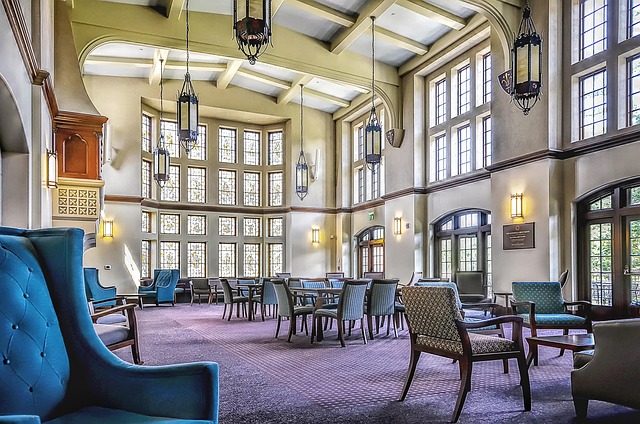Opting for eco-friendly student accommodation is a powerful way to minimize environmental impact and contribute to a greener future. Universities offer specialized sustainable options with energy-efficient designs, renewable energy sources, and recycling programs. Look for green buildings with natural lighting, efficient appliances, water conservation, and proximity to campus or public transport. Eco-conscious communities foster stewardship through shared resources like gardens and carpools, promoting practical skills in composting, water conservation, and responsible consumption. In your room, choose second-hand furniture, natural materials, energy-efficient LED bulbs, and plants for an eco-friendly setup. Create a stylish, sustainable dorm or off-campus pad with recycled/upcycled furniture, natural elements, energy-efficient lighting, and renewable power sources. Transform your bedroom into an eco-friendly sanctuary using energy-saving practices, smart thermostats, and Energy Star appliances.
“Discover how to make your student living space both environmentally conscious and comfortable with our comprehensive guide. We explore everything from locating eco-friendly student accommodation, including top tips for finding green housing options, to creating a sustainable room setup with eco furniture and energy-saving tricks.
Learn effective strategies for reducing your carbon footprint off-campus, optimizing shared spaces for energy conservation, and implementing water-saving practices. Join the movement by building an eco-conscious community through collaborative action and organizing campus initiatives.”
- Choosing Eco-Friendly Student Accommodation
- – Tips for finding green housing options
- – Benefits of living in eco-conscious communities
- Sustainable Room Setup Ideas
- – Eco-friendly furniture and decor choices
- – Energy-saving tips for your bedroom
Choosing Eco-Friendly Student Accommodation

When it comes to choosing where to live as a student, opting for eco-friendly accommodation is a fantastic way to reduce your environmental impact and contribute to a greener future. Many universities now offer specialized sustainable housing options, featuring energy-efficient designs, renewable energy sources, and recycling programs. These spaces not only promote eco consciousness but also often come with community-oriented amenities, fostering a sense of environment-focused camaraderie among residents.
Eco-friendly student accommodation can take various forms, such as green buildings constructed with sustainable materials, or existing properties retrofitted with eco-conscious features. Look for options that prioritize natural lighting, efficient appliances, and water conservation measures. Additionally, consider housing situated close to campus or public transportation hubs to reduce your carbon footprint associated with commuting.
– Tips for finding green housing options

Finding eco-friendly housing is a fantastic first step for students committed to sustainable living. Start by looking for buildings certified with green ratings or labels, like LEED (Leadership in Energy and Environmental Design). These certifications guarantee that the property meets specific environmental standards related to energy efficiency, water conservation, indoor air quality, and more.
Many student accommodations now advertise their eco-conscious features openly. Check listings for details about renewable energy sources, recycling programs, green cleaning practices, and water-saving fixtures. Additionally, consider living in communities with shared resources like communal gardens, bulk buying options, or carpool initiatives that align with your eco-conscious lifestyle aspirations.
– Benefits of living in eco-conscious communities

Living in an eco-conscious community offers a multitude of benefits for students looking to reduce their environmental impact and contribute to a sustainable future. One of the key advantages is the shared commitment to eco-friendly practices, such as energy conservation, waste reduction, and sustainable transportation options. This collective effort not only minimizes the community’s carbon footprint but also fosters a culture of sustainability that encourages individual behavioral changes.
Eco-conscious housing often incorporates green building design principles, using materials that are locally sourced, non-toxic, and energy-efficient. These communities may feature shared spaces optimized for resource sharing, such as communal gardens, solar panels, or recycling centers. Students living in such environments learn valuable skills in sustainable living, including composting, water conservation, and responsible consumption, which can significantly influence their lifestyle choices both during their studies and beyond.
Sustainable Room Setup Ideas

Creating an eco-conscious room setup is a fantastic way for students to contribute to sustainable living while enjoying their personal space. Start with essential furniture choices; opt for second-hand or vintage pieces to reduce demand for new manufacturing, which often has significant environmental impacts. Choose multi-functional items like a sofa bed that can serve as both seating and a sleeping area to minimize space wastage and resource use.
When decorating, embrace natural materials such as bamboo, cork, or upcycled fabrics. These options are not only eco-friendly but also add warmth and texture to your room. Consider energy-efficient lighting solutions like LED bulbs and utilize natural light as much as possible. Additionally, incorporate plants into your interior design; they not only improve air quality but also create a calming atmosphere, fostering a sense of connection with nature in your eco-friendly housing.
– Eco-friendly furniture and decor choices

Creating an eco-friendly space is a fantastic way for students to reduce their environmental impact while enjoying a comfortable living environment. When furnishing a dorm room or off-campus pad, opt for sustainable options that align with eco-conscious values. Choose furniture made from recycled or reclaimed materials, such as bamboo, upcycled wood, or metal from electronic waste. These unique pieces not only contribute to a greener planet but also add character and personality to your space.
Decorating on a budget doesn’t mean compromising on style or sustainability. Embrace natural elements by incorporating plants, which act as air purifiers while adding greenery to your living area. Opt for energy-efficient lighting, like LED bulbs, and consider using renewable power sources if available. Additionally, reusable and biodegradable textiles, such as cotton or linen, make excellent choices for bedding, curtains, and cushions, ensuring a cozy yet eco-friendly haven.
– Energy-saving tips for your bedroom

Transforming your bedroom into an eco-friendly haven is an easy and effective way to contribute to sustainable living, especially for students. One of the simplest energy-saving tips is switching to LED lights; they consume significantly less power than traditional bulbs. Additionally, utilizing natural light during the day by opening curtains or blinds can reduce the need for artificial lighting.
Another practical strategy is adopting smart thermostats and programming them to adjust temperatures based on your presence. This ensures energy isn’t wasted when you’re away at class or during sleep. Consider using energy-efficient appliances and electronics, opting for devices with the Energy Star label to minimize power consumption without compromising performance.






